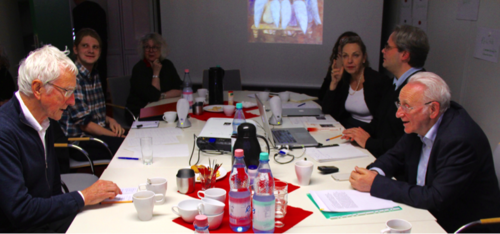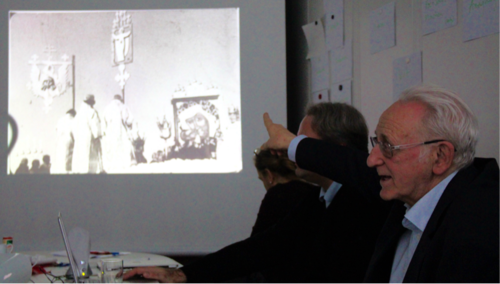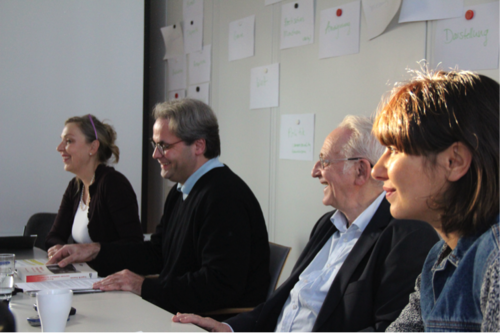Naum Kleiman: "Eisenstein and Metaphor—Theory and Practice Beyond Montage"
08.12.2015 | 14:00 Lecture by Naum Kleiman.
Left to right: Wolfgang Beilenhoff, Thomas Scherer, Christine Noll Brinckmann, Cornelia Müller, Michael Wedel, Naum Kleiman
Naum Kleiman – cinema historian, film critic, specialist in Sergei Eisenstein and former manager of the Moscow State Central Cinema Museum – paid a visit to Cinepoetics to give a lecture on Eisenstein's use of metaphor: "Theory and Practice Beyond Montage." Among the delighted audience were also renowned film scholars Wolfgang Beilenhoff and Christine Noll Brinckmann.
While the emergence of meaning in Eisenstein's theoretical writings and films is undeniably related to his systematic conception of montage (metric montage, rhythmic montage, intellectual montage, etc.), the principle of sensuous (or 'prelogical') thinking is central to Eisenstein's theory and its underlying idea of metaphoricity: According to Eisenstein, sensuous thought initiates a fluid interaction between the artwork and its beholders, whereby movement itself becomes a metaphor. It characterises our aesthetic perception of an artwork in such a way that it makes us respond to its materials, textures and formal qualities, establishing an emotional connection beyond the frame. Thus, in appealing to our prelogical thinking, metaphor also provides access to the essence of film experience—by means of movement, affectivity, and temporality.
After contextualising this thought within Soviet montage theory and its proposed "utopia of the definite shot", Kleiman talked in detail about the metaphoric relationship between iconic painting and Eisenstein's films. The historian concentrated on the emergence of meaning through certain principles of composition, which in fact goes far beyond the geometrical partitioning of the image space: By means of an inverted central perspective, iconic painting directly addresses the beholders, approaches them, making them part of the spiritual world represented. This way the perspective itself becomes a metaphorical form.
Kleiman also referred more broadly to Rubens' 1612 triptych "The Descent From the Cross" and Eisenstein's conception of Battleship Potemkin before turning to his central case study, the film Ivan Grosny (1944/58). Based on Eisenstein's drawings and production stills of one of the film's key scenes, Kleiman offered a meticulous analysis of how the concept of this specific sequence evolved in several stages, with every variation being a synthesis of different ideas and aesthetic conflicts realised in the interplay of mise-en-scène, graphic compositions, make-up, acting style, etc. Thus, in each envisioned version of the scene (a depiction of how the Russian people and the clergy beg the tsar to return to Moscow) the partitioning of the image space could for instance become a matter of costume and decor, or a character's posture. However, every single element each referred to a specific cultural context. The design of Ivan's coat, for instance, recalls the art of Japanese woodcut, while the people's procession portrayed in the scene reminds the audience of media news coverage of Lenin's burial. Eisenstein's creative premise is, in short, a mutual communication between concrete and abstract dimensions, which implies a metaphoric movement between multiple levels of meaning.
Kleiman thus offered valuable insights into the director's complex aesthetic framework, opening up spaces for further fruitful discussions and thoughts regarding the spectrum of cinematic metaphoricity.


